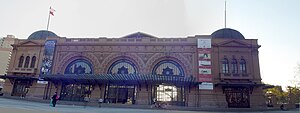Estación Mapocho
|
Estación Mapocho
|
|
|---|---|
| Disused train station | |

The facade of the Centro Cultural Estación Mapocho in 2006
|
|
| Location | Santiago, Chile |
| History | |
| Opened | 1913 |
| Closed | 1987 |
| Rebuilt | 1994 (as cultural centre) |
Estación Mapocho is a former train station that since 1994 has been refitted as a cultural centre that hosts many kinds of events.
The design and construction of the station began in 1905 at the hands of Emilio Jecquier, a Chilean architect based in France. The 280 metre long, 17 metre high structure was composed of a base of masonry and a steel vault covered in glass (now copper). The steel structure was constructed by the Belgian company Haine Saint Pierre. The official inauguration of the station took place on May 12, 1912, and the station opened to the public in 1913.
In many ways, Estación Mapocho is an relic of a significant period in Chilean history when the country was going through major economic and social changes, as well as celebrating its first centenary. The station was one of several civil works commissioned to celebrate the first centenary of Chilean independence, along with the park of Santa Lucía Hill, the Chilean High Court of Justice, and the Chilean National Museum of Fine Arts. The building is located at the intersection of two streets, Presidente Balmaceda and Bandera, on the south bank of the Mapocho River close to the Mercado Central de Santiago. Puente Cal y Canto metro station is beneath the "Plaza de la Cultura", or Culture Square, in front of the station.
For many years, Estación Mapocho was Santiago’s main rail hub serving Valparaíso, Argentina and northern Chile, which at the time was the centre of Chile’s niter or saltpeter boom.
In recognition of its imposing architecture and its sentimental and historic value, the building was declared a National Monument by law in 1976.
...
Wikipedia
